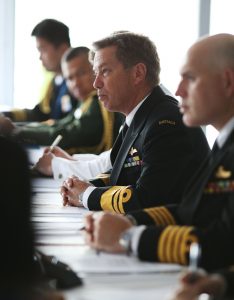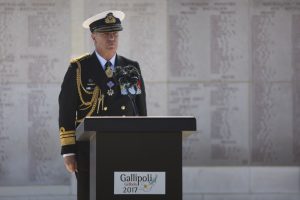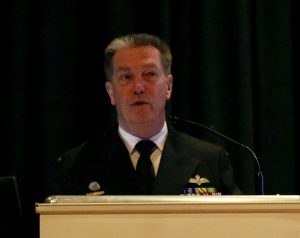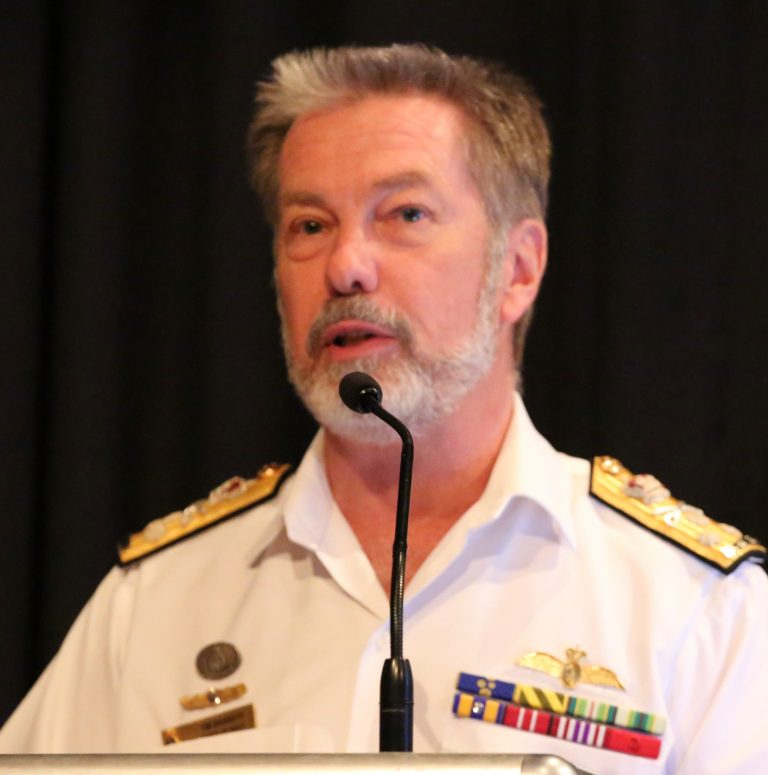Reshaping the Australian Navy Around Task Forces: The Perspective of Vice Admiral Barrett
During my visit to Australia in August 2018, I focus on several aspects of the rebuild of the Australian Navy. Throughout those discussions a key point has been the new approach to ship building and the interactivity of that approach with the focus on building an Australian task force capability.
In an earlier visit to Australia, in April 2017, I had a chance to talk with the then head of the Australian Navy, Vice Admiral Tim Barrett and here is what he had to say about the evolving approach for the Royal Australian Navy.
This interview was first published on May 2, 2017.
During my most recent trip to Australia, the focus was upon how to shape an integrated ADF moving forward.
During my interviews surrounding the Williams Foundation seminar on that theme, I have had the chance to talk to key decision makers in shaping a way ahead.
Last August, I had a chance to talk with the Chief of the Australian Navy, Vice Admiral Tim Barrett.
And this interview underscored a key element of how the ADF is rebuilding itself to operate with greater flexibility and sovereignty.
A key speaker at the Williams Foundation seminar on air-land integration was the Chief of the Australian Navy, Vice Admiral Tim Barrett.
Barrett’s speech focused on the opportunities and challenges of the largest recapitalisation of the Australian Navy since World War II.
New submarines, destroyers and amphibious ships and associated fleet assets are being built in Australia to shape a new maritime capability for Australia.
But this force is being built in the time of significant innovation in the Pacific whereby new force concepts are being shaped, such as kill webs, distributed lethality, and fifth generation airpower.
Barrett made it very clear that what was crucial for the Navy was to design from the ground up any new ships to be core participants in the force transformation process underway.
We picked up where we left off from our August meeting.
Question: How do fight with the fleet you have and prepare at the same time for tomorrow’s fleet, especially when you have several new programs in the pipeline?
Vice Admiral Tim Barrett: You have to fight with the fleet you have now.
That is not an option; it is a necessity.
My focus to do that better and to lay the groundwork for the future fleet is to focus upon availability of assets.
 Chief of Navy, Vice Admiral Tim Barrett, AO, CSC, RAN holds the floor, during the Indian Ocean Naval Symposium (IONS) Conclave of Chiefs. Australia currently holds the Chairmanship of IONS. The regional forum was held during Sea Power 2015. *
Chief of Navy, Vice Admiral Tim Barrett, AO, CSC, RAN holds the floor, during the Indian Ocean Naval Symposium (IONS) Conclave of Chiefs. Australia currently holds the Chairmanship of IONS. The regional forum was held during Sea Power 2015. *
How to we get our availability rates higher?
How do we get ships to sea more effectively and more often?
They are not going to make much difference sitting in drydocks.
One can provide for enhanced deterrence through enhanced availability.
Question: You certainly don’t win with Power Point slides, do you?
Vice Admiral Tim Barrett: You certainly don’t nor with a connected force in those slides, represented by lightening bolts but not realized in practice.
For example, we have a small submarine fleet of six submarines; they are not going deter anybody if they are not available and capable of going to see.
As we discussed last time, we have put a major effort in getting much greater availability from our Collins class submarines, and the ways we have done so will shape our approach, our expectations and our template for the operation of the new class of submarines.
We have seen a dramatic improvement in our Collins Class boats.
Question: In other words, by learning how to ramp up availability with today’s fleet you are preparing the template for future operations?
Vice Admiral Tim Barrett: That is clearly our approach going forward.
We should be building our sense of availability in the design right now, so that when the future frigates arrive in place, we have maximized availability, and through that deterrence given their contribution to a distributed lethal force capability.
And this clearly is a key challenge for the workforce to shape enhanced availability.
We are reworking our work force to do so today, but must prepare for the transition in the workforce to do so in the future, recognizing that tomorrow’s platforms will be different, and different skill sets required ensuring enhanced availability.
Government has committed to a future navy in terms of key new platforms.
I have that as a target goal so can work from here to there rather than simply fighting for the need to have a future fleet.
This certainty is crucial in allowing me to work the transition.
As we shape task force concepts for the current fleet, we are working connectors to make the fleet more effective in our task force approach.
As we work those connectors we are also anticipating how to build those into the design of the new fleet, rather than having to work the problem after we have acquired the platforms.
Question: And this is not simply about Navy, you focus is broader?
Vice Admiral Tim Barrett: It is; it is about working with industry; it is about working with the ADF; it is about working with government; in essence it is about the commitment of the nation.
We are a small force; smaller than the New South Wales Police Force.
We can not do this without a national commitment.
 Chief of Navy, Vice Admiral Tim Barrett, AO, CSC, RAN, delivers the Ode of Remembrance at the Lone Pine commemorative service in Gallipoli.
Chief of Navy, Vice Admiral Tim Barrett, AO, CSC, RAN, delivers the Ode of Remembrance at the Lone Pine commemorative service in Gallipoli.
Question: One aspect of change clearly is building 21st century defense structure.
I have just returned from the UK and witnessed their significant efforts at Lossiemouth, Waddington, Marham and at Lakenheath to have a new infrastructure built.
And certainly have seen that at RAAF Williamtown with the F-35 and at RAAF Edinburgh with the P-8/Triton.
How important in your view is building a new infrastructure to support a 21st century combat force?
Vice Admiral Tim Barrett: Crucial.
And that is in part what I am referring to as an industrial and national set of commitments to shaping a 21st century combat fleet.
We spoke last time about the Ship Zero concept.
This is how we are focusing upon shaping a 21st century support structure for the combat fleet.
I want the Systems Program Office, the Group that manages the ship, as well as the contracted services to work together on site.
I want the trainers there, as well, so that when we’re maintaining one part of the system at sea, it’s the same people in the same building maintaining those things that will allow us to make future decisions about obsolescence or training requirements, or to just manage today’s fleet.
I want these people sitting next to each other and learning together.
It’s a mindset.
It puts as much more effort into infrastructure design as it does into combat readiness, which is about numbers today.
You want to shape infrastructure that is all about availability of assets you need for mission success, and not just readiness in a numerical sense.
Getting the right infrastructure to generate fleet innovation on a sustained basis is what is crucial for mission success.
And when I speak of a continuous build process this is what I mean.
We will build new frigates in a new yard but it is not a fire and forget missile.
We need a sustained enterprise that will innovate through the life of those frigates operating in an integrated ADF force.
That is what I am looking for us to shape going forward.
Question: An example of your approach to the future is clearly the new submarine.
A French design house and an American combat systems company will be working together really for the first time.
And they are building a submarine which has never been built before.
This provides an opportunity for you to shape a new support structure along the lines you have described going forward.
How do you see this process?
Vice Admiral Tim Barrett: It is something new and allows us to shape the outcome we want in terms of an upgradeable sustainable submarine with high availability rates built in. We intend to see this built that way from the ground up.
It is not simply about acquiring a platform.
We will not be a recipient of someone else’s design and thought.
This will be something that we do, and we will work with those that have a capacity to deliver what we say we need.
I think the way you characterize the process makes sense.
The experiences we’ve had through Collins have taught us a lot.
With 12 of these future submarines in a theater anti-submarine role we think we can make an effective contribution to our defense and to working with core allies in the region, notably the US Navy.
Editor’s Note: Vice Admiral Barrett has published a new book this year entitled The Navy and the Nation and Ed Timperlake recently commented on this book as follows:
The Aussies are not just buying new equipment; they are rethinking how to integrated that force and make a more effective and lethal combat capability.
A recent publication by the Australian Chief of Navy illustrates the point.
Australia’s Vice Admiral Tim Barrett has written a brilliant book about maritime power.
It is what is known as a “good read” because it is written with great insights presented in easily understandable prose.
He shows the reader why “The Navy and the Nation” is a sacred bond.
This passage is one of the most powerful ever written about the role of a Navy and the connection with their citizens:
“Most People think the Navy is something else.
“They know it exists, the may even have a rough idea of what it is for, but they don’t think it’s got much to do with them.
“They’re wrong.
“The Navy is a national enterprise in which everyone is involved and which everyone is involved and which delivers peace and security to everyone in the country.
“This enterprise is a two-way street, and must be a two-way street.
“Going one way, the Navy offers peace and security. Going the other, the people offer support and contribution. Only when the street is a properly mutual two-way exchange between the Navy and the citizens can this bargain, this contract, deliver what it needs to.”
And an earlier interview with Admiral Barrett provides further insight into the changing approach of the Australian Navy and the key role of the evolving task force concept:
2016-09-01 By Robbin Laird
A key speaker at the Williams Foundation seminar on air-land integration was the Chief of the Australian Navy, Vice Admiral Tim Barrett.
Barrett’s speech focused on the opportunities and challenges of the largest recapitalization of the Australian Navy since World War II.
New submarines, destroyers and amphibious ships and associated fleet assets are being built in Australia to shape a new maritime capability for Australia.
But this force is being built in the time of significant innovation in the Pacific whereby new force concepts are being shaped, such as kill webs, distributed lethality, and fifth generation airpower.
Barrett made it very clear that what was crucial for the Navy was to design from the ground up any new ships to be core participants in the force transformation process underway.

In his presentation at the conference, he underscored that “we are not building an interoperable navy; we are building an integrated force for the Australian Defence Force.”
He drove home the point that ADF integration was crucial in order for the ADF to support government objectives in the region and beyond and to provide for a force capable of decisive lethality.
By so doing, Australia would have a force equally useful in coalition operations in which distributed lethality was the operational objective.
He noted that it is not about massing force in a classic sense; it is about shaping a force, which can maximize the adversary’s vulnerabilities while reducing our own.
And he re-enforced several times in his presentation that this is not about an ‘add-in, after the fact capability’; you need to design and train from the ground up to have a force trained and equipped to be capable of decisive lethality.
He quoted Patton to the effect that you fight war with technology; you win with people.
It is about equipping the right way with right equipment but training effectively to gain a decisive advantage.
The recapitalisation effort was a “watershed opportunity for the Australian Navy.”
But he saw it as a watershed opportunity, not so much in terms of simply building new platforms, but the right ones.
And with regard to the right ones, he had in mind, ships built from the ground up which could be interoperable with JSF, P-8, Growler, Wedgetail and other joint assets.
“We need to achieve the force supremacy inherent in each of these platforms but we can do that only by shaping integrated ways to operate.”
He highlighted that the Navy was in the process of shaping a 21st century task force concept appropriate to a strategy of distributed lethality and operations.
A key element of the new approach is how platforms will interact with one another in distributed strike and defensive operations, such as the ability to cue weapons across a task force.
After his presentation, I had the chance to sit down with Vice Admiral Barrett and to expand the conversation.
Clearly, a key element in his thinking is how to get the new build of ships right for an age in which one wants to build an integrated, but distributed force.
Question: It is clear that you are taking the long view of getting the ship building piece of this right in terms of ensuring that ships are not built simply as separate platforms, but as building blocks in an integrated force.
How do you do that?
Vice Admiral Barrett: “I am taking a very long view, and believe that we need to build our ships in Australia to generate naval capabilities integrated within the ADF.
“We need agility in the process of changing ships through life—continuing to evolve the new ships depending on how the threat is evolving.
“This means that we need to control the combat system software as well as build the hulls. We will change the combat system and the software many times in the life of that ship; whereas, the hull, machinery in the plant doesn’t. That might sound like a statement of the obvious.
“But it’s not a statement that’s readily understood by our industry here in Australia.
“We need to organise ourselves to have an effective parent navy capability.
“We need to manage commonality across the various ship build processes.
“That will not happen if we build someone else’s ship in Australia which is designed to operate in separate classes.
“I don’t want an individual class to be considered in isolation. I want to cross-learn and cross-operate throughout our various classes of ships, and notably with regard to software integration and development.”
Question: Clearly, building a sustainable navy from the outset is crucial to your design effort.
How do you view the challenge of building a more sustainable navy from the outset?
Vice Admiral Barrett: “It is crucial to deterrence. If your ships are not operating at sea they will have little effect.
“For example we have changed our approach to the Collins submarine largely around sustainment and working more openly with industry to achieve much greater at-sea operational tempos.
“We have put in place an enterprise approach, which focuses on availability of submarines; Industry and Navy are working closely together now to achieve that core objective.
“I’ve got industry keenly interested in the results of what the submarines do when they leave port and go on operations. And we’ve had a dramatic turnaround in submarine availability as partnering has improved.
“For me, deterrence, lethality, availability, sustainability, and affordability are highly interrelated for a Navy and its combat performance.
“And clearly as we design new ships, designing in more sustainable systems and ships is crucial.”
Question: Wedgetail shows an interesting model, namely having the combat squadron next door to the Systems Program Office.
This facilitates a good working relationship and enhances software refresh as well.
You have something like this in mind for your ship building approach.
Could you discuss that approach?
Vice Admiral Barrett: “We do and are implementing it in our new Offshore Patrol Vessel program. And with our ‘ship zero’ concept we are looking to integrate the various elements of operations, upgrades, training and maintenance within a common centre and work flow to get greater readiness rates and to enhance an effective modernization process as well.
“We are reworking our relationship with industry because their effectiveness is a key part of the deterrence process. If I have six submarines alongside the wharf because I can’t get them away, they are no longer lethal and they are no longer a deterrent force.
“Again, as an example we have dramatically improved availability by building maintenance towers alongside the submarine—rather than the previous way that it was done, where people arrived into that one gangway under the submarine then dispersed to do their maintenance work—is an example of how we need to work.
Question: In your presentation, you mentioned working with various air systems.
Could you discuss, Navy’s role in Wedgetail?
Vice Admiral Barrett: “We have Navy officers onboard who already provide a key communication role to the Air Force officers onboard the Wedgetail. They can inform those officers of the decision process on the ship and, conversely, explain later to those onboard the ships, what Wedgetail can do for them.
“Put in other terms, by such a work flow, augmented by the growing engagement of Virtual Wedgetail in navy training, Wedgetail becomes part of the maritime warfare system within the ADF.
“Wedgetail is an example of the way ahead for air-naval integration.”
For a biography of Vice Admiral Barrett, see the following:
http://www.navy.gov.au/biography/vice-admiral-tim-barrett
For an overview on the Navy’s transformation plan, Plan Pelorus, see the following:
http://video.defence.gov.au/play/1989#
According to Vice Admiral Barrett in a speech delivered earlier this year, the Chief of Navy provided this overview to the transformation approach:
PELORUS recognises the need for technologically-advanced ships to combine in the modern fleet system, and to integrate seamlessly in the joint and networked environment.
This is a plan which recognises the need for ships to be capable of delivering the lethal force on which deterrence depends. It is a hard-nosed plan; one that recognises the need for ships to be affordable, adaptable and available—and ready to serve the nation’s needs.
But Plan PELORUS looks beyond individual ships. It recognises that in the future, ships will only be entirely capable when they operate in fleet systems.
In the future, the whole will be massively greater than the sum of its parts. PELORUS is also about our people.
They remain what they have always been— the greatest single factor in our success in operations. PELORUS addresses those serving now and those we need to recruit.
http://www.adfjournal.adc.edu.au/UserFiles/issues/199%202016%20Mar_Apr.pdf
Royal Australian Navy Strategy 2018 from SldInfo.com on Vimeo.

